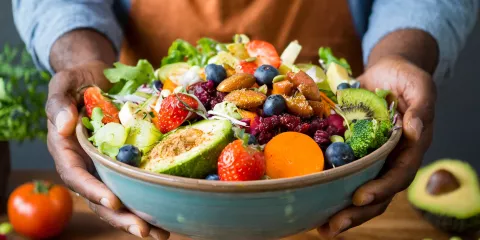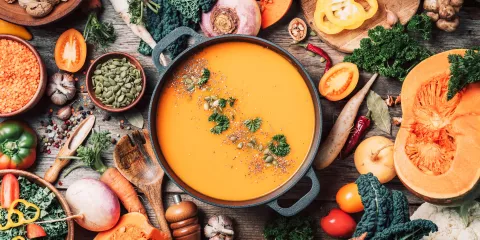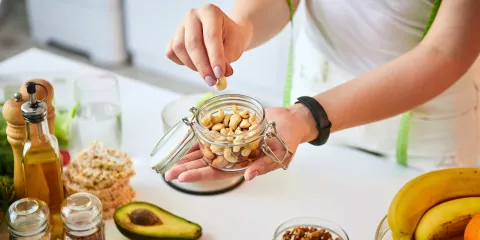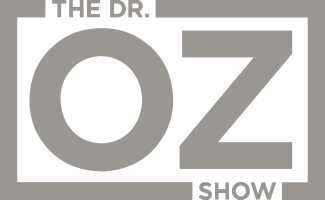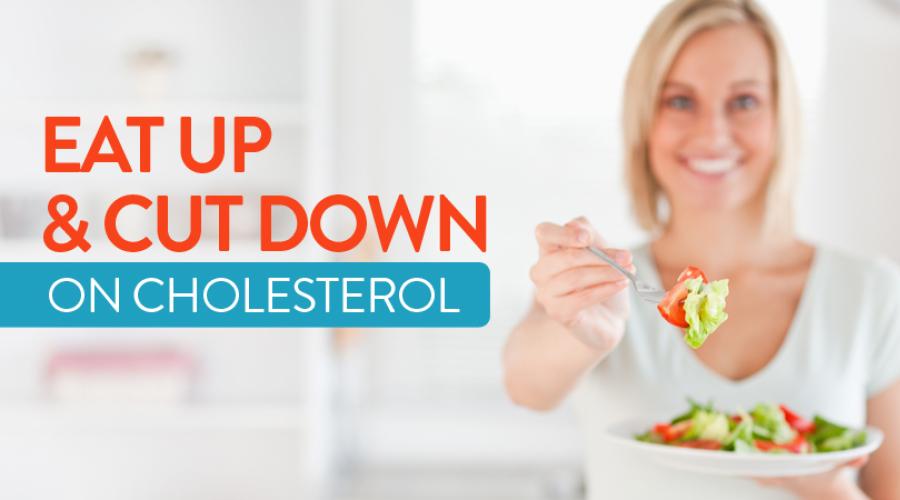
Here’s the problem with the bran muffin: Although bran can help lower LDL cholesterol, the butter, sugar and eggs aren't doing your LDL levels any favors. While this bran muffin may not raise your cholesterol, it certainly won’t help you lower it. And lowering harmful cholesterol levels is what most of us need to do.
What about non-fat bran muffins? Well, aside from the awful taste, they are usually loaded with sugar, which creates a host of other problems. So non-fat bran muffins are typically a sleight-of-hand name that tricks you into eating a not-healthy thing in place of another not-healthy thing.
As we discussed in an earlier post, Where Cholesterol Really Comes From, cholesterol—even LDL cholesterol—is not inherently “bad.” What is bad is a buildup of LDL cholesterol. Because of the great availability of high-fat foods and foods that produce inflammation in vessels and cells, American diets are very susceptible to harmful LDL buildup. But it turns out that eating right doesn't just help prevent buildup of LDL, some foods can actually help lower harmful levels of LDL cholesterol. Here are a few of them:
1. Bran
Bran works powerfully against LDL buildup. But first, what exactly is bran? Bran is the layers of hard, outer husk of nearly any cereal grain, including oats, wheat, rice and corn. These dense outer layers are great sources of nutrients and fiber, so 5-10 grams per day is advised. But loading up the bran with butter and sugar is not the way to do it. Steel-cut oatmeal (dressed with fresh fruit and a drizzle of honey instead of sugar) is a great source of bran, as are cold cereal products made with oat bran.
2. Fruits
Soluble fiber is the stuff in bran that helps lower your LDL cholesterol, but foods other than bran are also high in soluble fiber. These include prunes, pears and apples. Apples have the additional benefit of being rich in flavonoids. Flavonoids are essential for improving your nitric oxide status, which can help relax your blood vessels after rapid rises in heart rate and blood pressure.1 Like your grandmother and your grandmother’s grandmother said, “An apple a day keeps the doctor away.”
3. Beans
Some beans—especially kidney beans—are also full of soluble fiber, but all beans are good for lowering LDL cholesterol (the kind you generally want to lower). One additional trick that beans play is that they take a while to digest, which can help someone feel full longer. However, the bran muffin caution applies: Many beans, including refried beans, are prepared with copious amounts of lard. If you make sure your beans are not prepared with any harmful additives, you can enjoy them, feel full and help lower your level of LDL cholesterol. It’s a win-win-win.
4. Phytosterols
Sterols are organic molecules that occur in most life forms. Phytosterols are sterols found in plants and have been shown to block cholesterol absorption in humans.2 If you’re trying to lower your cholesterol, you should eat foods that are high in phytosterols, including nuts (almonds, walnuts, pistachios), fresh fruits and vegetables (broccoli, brussel sprouts, blueberries, raspberries) and whole grains (flax seed and wheat germ). Besides being good for you in many other ways, some research suggests that foods high in phytosterols can actually help reduce your LDL cholesterol levels by at least 10 percent and possibly more.1
5. Soy
Soybean products—tofu, soy milk and others—can lower LDL cholesterol by about 5 percent to 6 percent if you consume about 25 grams per day. Now, a tofu taco may not be as immediately tasty as a carne asada taco, but replacing a fatty meat with tofu once a week or so can go a long way. Note: Scientists have adjusted downward the cholesterol-lowering effects of soy in recent years, but they still believe soybean products are good soldiers in the fight against cholesterol.
6. Olive Oil
Cooking with oil is probably unavoidable for most of us, but if you do want to cook with oil, use olive oil. It’s high in calories, but it contains many heart-healthy antioxidants. Virgin or extra-virgin olive oil are the ones to go with because they are free of excessive processing.
7. Fish
Which population has historically had a lower incidence of cholesterol-related heart disease? The answer is the fish-eaters, specifically, the Japanese. As the Japanese have adopted more Western practices, however (including diet), their rates of hypercholesterolemia have risen.4 The fact remains, though, that diets that are high in fish—if the fish is prepared without frying—produce significantly lower cholesterol levels than diets that are high in fatty meats. Speaking of fish, fish oil is among the cholesterol-lowering nutrients that can be found in the form of...
Remember: Cholesterol is necessary and good. Buildup of LDL cholesterol is neither. But fighting against LDL buildup does not have to taste bad. There are plenty of delicious foods out there that can actually help you in your effort to maintain healthy LDL cholesterol.
References
- Phytosterols and cholesterol metabolism. Department of Internal Medicine, Washington University, St. Louis, Missouri. http://www.ncbi.nlm.nih.gov/pubmed/15166807
- Apple phytochemicals and their health benefits. Jeanelle Boyer and Rui Hai Liu. Nutrition Journal 2004, 3:5.
- Ostlund RE, Racette SB, Stenson WF. Inhibition of cholesterol absorption by phytosterol-replete wheat germ compared with phytosterol-depleted wheat germ. Am J Clin Nutr 2003; 77 (6): 1385–9.
- Kita T. Coronary heart disease risk in Japan – an East/West divide? European Heart Journal Supplements 2004; 6 (Supplement A), A8–A11.

